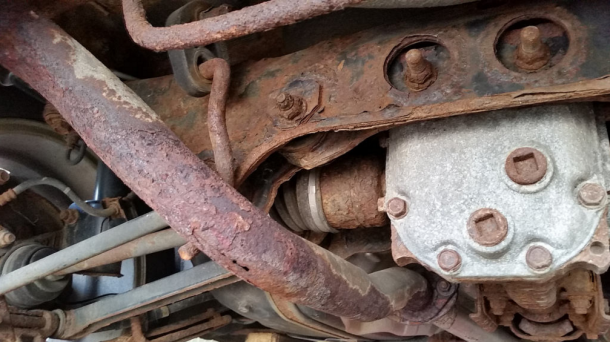Beaten by a Winter Beater?
Posted on Oct 23, 2015 in Editorials | 1 comment

Mo writes:
Sir,
I’m hoping to get advice from you and/or the B&B regarding my new-to-me 2004 Subaru Impreza Outback Sport (soon to be superleggera due to rust). Included is a link to pictures I took of the underside of my car and brakes with descriptions. [Thanks for those! – SM]
Questions:
– First and most important: Is it even worth fixing/preventing the rust from getting worse or should I just take it out back and put it down?
– If not euthanasia worthy, can I hack and scrape away the rust and use a rust neutralizer and sealer or should I physically replace as many parts as budget allows?
– Are said rust treatments liquid enough to get between seams or do they just reach areas that are visible?
– Regarding the brakes: I just changed the front rotors and pads (not shown). The pads removed from the vehicle still had maybe 3/4 life left and were wearing evenly (no tapering, gouging, etc.). Why was the rotor still rough?
– Should you feel a what I can describe as a grittiness when I move the front caliper sliding pins? (Dust covers are present and not torn.)
– Should you be able to move the caliper by hand once tightened? (With sliding and mounting bolts tightened, I can still move the caliper slightly at the sliding pin area in and out and side to side. I will say that I hadn’t pumped the brakes at the time I checked it.)
I had bought the car with the intention to use it as a winter car. That doesn’t mean if salvageable I won’t try and keep it running. So, should I walk away or roll up my sleeves?
Sajeev answers:
Maaaaan, forget all your questions! That thing is toast unless you want to strip it down to try the rust treatments in all the corners, crevices and sheetmetal folds. That much work for a winter beater? No thank you!
I’d rather buy one with a blown motor/theft recovery/insurance write off from a southern state and put all your Subie’s guts into that. And maybe put rust inhibitor on that southern car if you’re gonna go to the trouble. But again, not for a winter car!
Mo responds:
Ugh. I was worrying about that. I’d never seen axles flake before. I guess buyer beware and all that. As I said, I’d gotten it as a beater, and at least from a quick visual inspection at the lot (not on lift) it looked alright. But, I guess it being from VT didn’t do it any good.
At least from what I saw once I put it on the lift, it hasn’t fallen apart (yet). My plan was to scrape and poke and pound as much out as I could and spray that rust stuff — then cross my fingers.
Sigh. Honestly, besides that (and the diesel tractor engine knock), I’d fallen in love with the way it handles and rides.
Thanks for the advice. Now I just don’t know if I should try selling it, part it out or do the underbody on my nice car instead.
Sajeev concludes:
Engine knock?
Part it out and claw back some of your money! If the interior is clean and you work eBay, the Subie forums and Craigslist hard (from the comfort of your warm abode) you might make money on the deal. I’d much rather disassemble to cash out than make any attempt at rust repair.





Welcome to the salted hell that is the North. I didn’t even bat an eye when I saw the above photo. I’d take a screw driver and poke all over the subframes (front and rear). If it punches through, depending on severity I’d say drive it this winter and then ship it on down the line. If everything is solid, I’m still not sure that any sort of treatment would really make a difference at this point. Soaking with something like Fluid Film that creeps well might slow the process, but when you’re that far along I’d argue it’s just too late. I’d focus on checking all underbody fuel and brake lines, and focus my rustproofing efforts there. My guess is that they’re in bad shape.
Lubricate the caliper pins for sure. In fact, those calipers look so crusty I’d consider just replacing them altogether. And in the North I think the number one reason for rotors being replaced isn’t wear, it’s rust the grows in from the edges to the middle of the wear surface. Especially common on rear disk brakes (#1 reason to choose rear drums IMO).